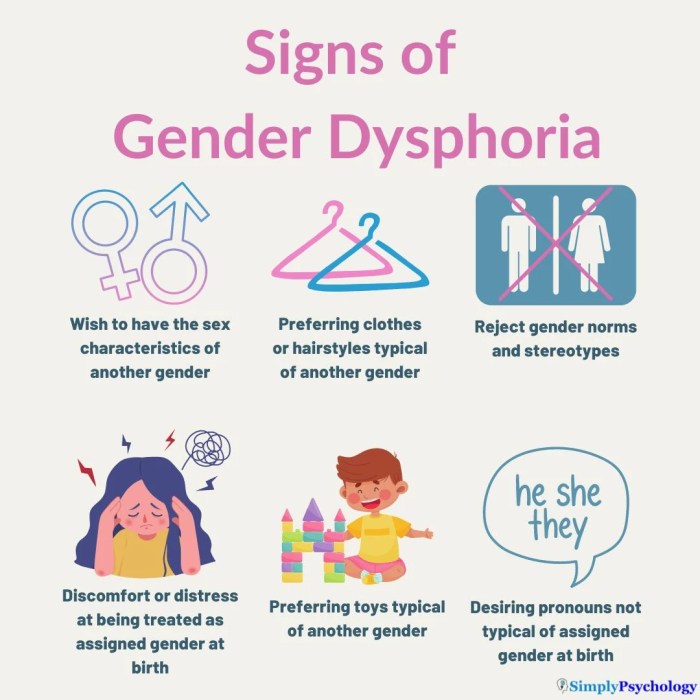Ever wondered what it means to be “you”? In a world that often feels like it’s trying to fit us all into boxes, understanding gender identity is more important than ever. This guide takes a deep dive into the world of pronouns, gender dysphoria, and the journey of self-discovery.
Think of it like a super-powered cheat sheet for unlocking your most authentic self, complete with tips and tricks for navigating this complex landscape.
We’ll break down the difference between sex and gender, explore the diverse spectrum of gender identities, and explain the crucial role of pronouns in fostering inclusivity and respect. We’ll also discuss gender dysphoria, its impact on individuals, and the resources available to support those experiencing it.
Ready to embrace your true self? Let’s dive in!
Understanding Gender Identity
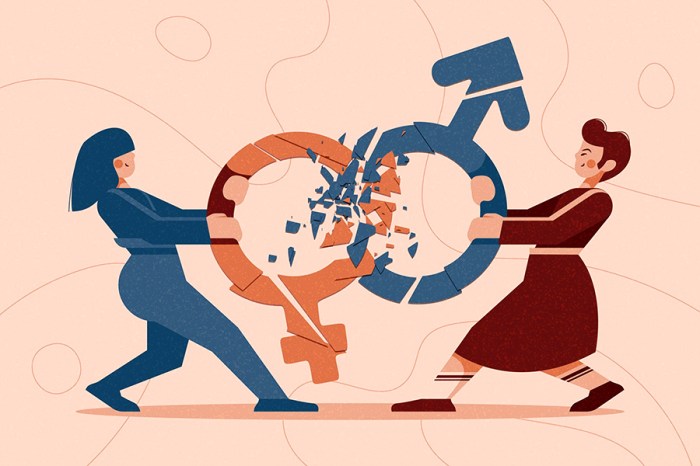
Let’s talk about gender identity, a topic that’s become more prominent in recent years. It’s important to understand that gender identity is a personal experience, and it’s crucial to respect the identities of others.
Sex vs. Gender
Sex and gender are distinct concepts. Sex refers to biological characteristics, typically assigned at birth based on anatomy, chromosomes, and hormones. Gender, on the other hand, is a social construct that refers to the roles, behaviors, expressions, and identities that a society associates with being male, female, or other genders.
Gender Identity
Gender identity is an individual’s deeply felt sense of their own gender. It’s about how someone identifies internally, regardless of their sex assigned at birth. Gender identity can align with the sex assigned at birth, or it can differ.
Gender Identity vs. Sexual Orientation
Gender identity is not the same as sexual orientation. Sexual orientation refers to a person’s emotional, romantic, and/or sexual attraction to others. It’s about who you are attracted to, not how you identify your gender. For example, a transgender woman may be attracted to men, women, or both.
Examples of Gender Identities
- Transgender:A person whose gender identity differs from the sex they were assigned at birth.
- Non-binary:A person whose gender identity does not fit within the binary categories of male or female. Non-binary people may identify as genderfluid, agender, bigender, or use other terms.
- Genderfluid:A person whose gender identity fluctuates over time.
Experiences of Transgender and Non-Binary Individuals
Transgender and non-binary individuals may experience gender dysphoria, which is a sense of discomfort or distress that arises from a mismatch between a person’s gender identity and the sex they were assigned at birth. This discomfort can manifest in various ways, including feelings of anxiety, depression, and difficulty with social interactions.
Understanding your gender identity is a journey, and it’s totally cool to explore different parts of yourself. Learning about pronouns and gender dysphoria can help you figure out what feels right for you, and that’s super important for feeling authentic.
Check out this super interesting book, e-aibisyouzyozukan mizugihenn (syasinnsyuu) (Japanese Edition) , which delves into the nuances of self-expression and how to be your truest self. It’s all about embracing your unique identity and rocking your own vibe, no matter what!
Understanding Gender Identities
| Gender Identity | Characteristics |
|---|---|
| Cisgender | A person whose gender identity aligns with the sex they were assigned at birth. |
| Transgender | A person whose gender identity differs from the sex they were assigned at birth. |
| Non-binary | A person whose gender identity does not fit within the binary categories of male or female. |
| Genderfluid | A person whose gender identity fluctuates over time. |
| Agender | A person who does not identify with any gender. |
| Bigender | A person who identifies with two genders. |
Pronouns and Their Importance
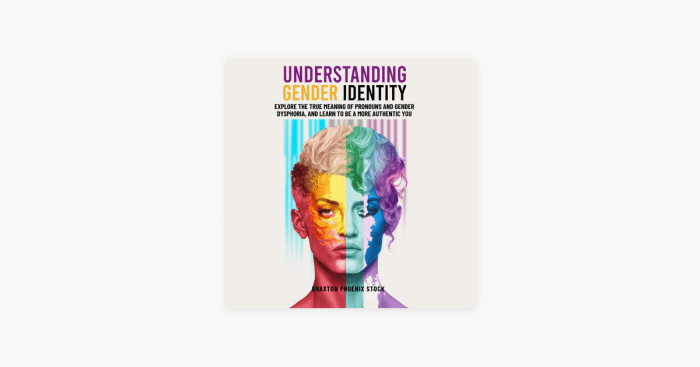
Pronouns are words that replace nouns, and in the context of gender identity, they are crucial for respecting and acknowledging someone’s self-identified gender. Using the correct pronouns for someone is a fundamental way to show respect, create a safe and inclusive environment, and build trust.
Feeling lost in the world of pronouns and gender identity? Want to learn how to be your most authentic self? Check out Download And Listen Here for some seriously helpful info on navigating gender dysphoria and embracing who you truly are.
You’re not alone on this journey, and there are tons of resources to help you find your way.
Impact of Misgendering
Misgendering someone, which means using the wrong pronouns for them, can be deeply hurtful and disrespectful. It can make someone feel invalidated, disrespected, and even unsafe. Imagine being constantly called by a name or pronoun that doesn’t align with your identity.
It can feel like your very existence is being denied. Misgendering can also have a negative impact on mental health, leading to increased anxiety, depression, and even suicidal thoughts.
Promoting Inclusivity and Respect
Using someone’s preferred pronouns is a simple yet powerful act of respect and inclusivity. It shows that you recognize and value their identity. When you use the correct pronouns, you create a more welcoming and affirming environment for everyone. Imagine a world where everyone feels comfortable and respected for who they are, regardless of their gender identity.
This is the kind of world we can create by using the right pronouns.
Asking for Preferred Pronouns
Asking for someone’s preferred pronouns is a simple and respectful way to ensure you are using the correct ones. Here are some ways to ask:
- “What pronouns do you use?”
- “Can you tell me your preferred pronouns?”
- “I’m still learning about pronouns. Would you mind sharing yours with me?”
It’s important to be respectful and avoid making assumptions about someone’s pronouns based on their appearance or name.
Pronoun Sets and Their Meanings
| Pronoun Set | Meaning |
|---|---|
| He/Him/His | Used for individuals who identify as male. |
| She/Her/Hers | Used for individuals who identify as female. |
| They/Them/Their | Used for individuals who identify as non-binary or gender-neutral. |
| Ze/Zir/Zirs | An alternative pronoun set for individuals who identify as non-binary or gender-neutral. |
Remember, everyone’s gender identity is unique, and using the correct pronouns is a fundamental way to show respect and create a more inclusive world.
Gender Dysphoria and Its Impact
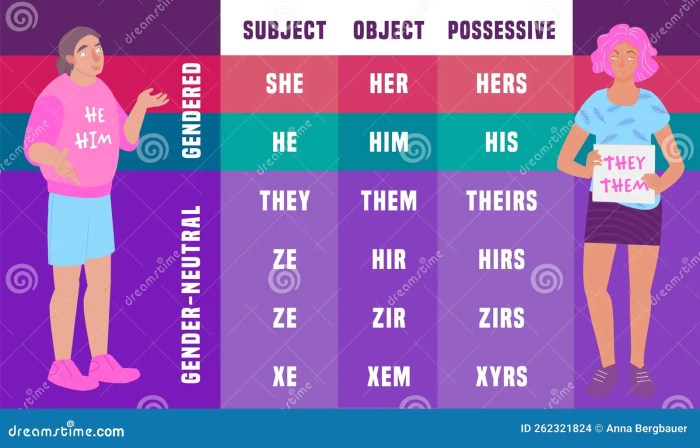
Gender dysphoria is a feeling of discomfort or distress that occurs when a person’s assigned sex at birth doesn’t align with their gender identity. It’s a complex and deeply personal experience that can manifest in various ways, affecting individuals emotionally, psychologically, and in their daily lives.
Understanding your gender identity is a journey, and just like learning to paint wildflowers in watercolor, it takes time and practice. You might feel like you’re just starting out, but with patience and the right tools, you can create something beautiful.
If you’re looking for guidance on that artistic journey, check out The Painting Wildflowers Bible Techniques for Beginners and Experts Create Stunning Botanical Art in Watercolor with Step-by-Step Guidance , which will help you master those delicate brushstrokes. Just like learning to express your true self, it’s all about finding the right techniques and letting your creativity bloom.
Understanding Gender Dysphoria
Gender dysphoria is not a mental illness. It’s a natural and valid experience for many people who identify as transgender, non-binary, or gender non-conforming. It’s essential to recognize that gender dysphoria is a spectrum, and its intensity can vary greatly from person to person.
Some individuals may experience mild discomfort, while others may face severe distress.
Emotional and Psychological Effects of Gender Dysphoria
Gender dysphoria can lead to a wide range of emotional and psychological effects, including:
- Anxiety and depression
- Low self-esteem and body image issues
- Social isolation and difficulty forming relationships
- Increased risk of self-harm and suicidal thoughts
- Difficulty concentrating and focusing
Impact on Daily Life
Gender dysphoria can significantly impact an individual’s daily life. This can include:
- Feeling uncomfortable or distressed when using public restrooms or changing rooms
- Avoiding social situations where they feel misgendered or judged
- Experiencing difficulty in their chosen profession or career due to gender-related issues
- Struggling with clothing choices and personal appearance
- Feeling alienated or disconnected from their family and friends
Resources and Support Systems
There are many resources and support systems available for individuals experiencing gender dysphoria. These include:
- Mental health professionals specializing in gender identity and dysphoria
- Support groups and online communities for transgender and gender non-conforming individuals
- Organizations dedicated to advocating for transgender rights and providing resources
- Medical professionals who specialize in gender-affirming care
Mental Health Professionals Specializing in Gender Identity and Dysphoria
Finding a qualified mental health professional who specializes in gender identity and dysphoria is crucial for individuals seeking support and guidance. These professionals can provide:
- Therapy and counseling to address the emotional and psychological impacts of gender dysphoria
- Support and guidance in navigating the process of coming out and transitioning
- Information and resources related to gender identity and dysphoria
- Referrals to other professionals, such as medical providers or legal advocates
Embracing Authenticity
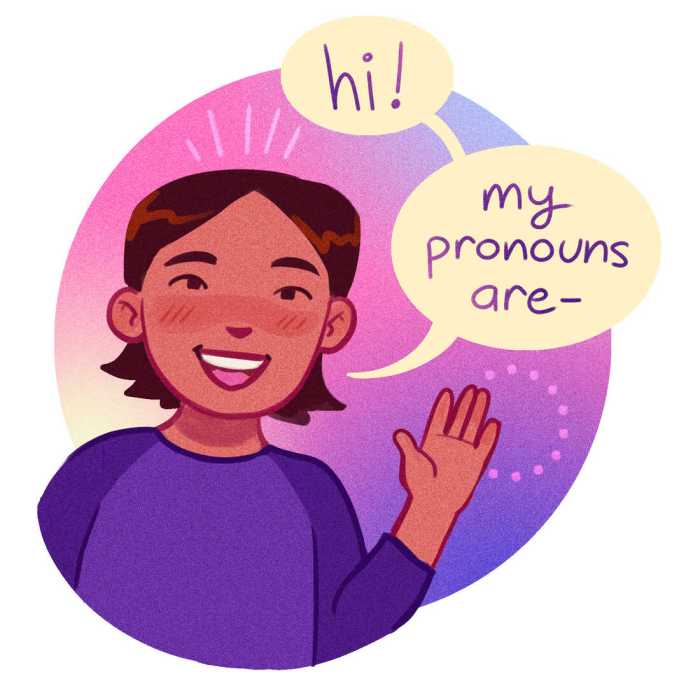
You’ve learned about gender identity, pronouns, and gender dysphoria. Now, it’s time to dive into the heart of the matter: embracing your true self. This journey is about self-acceptance and living authentically, regardless of societal expectations. It’s about owning your identity and creating a life that aligns with who you truly are.
Exploring your true self can be a wild ride, and figuring out your gender identity is like finding the perfect shade of lipstick – it’s all about what feels right. Sometimes, getting to know yourself better means taking a break from the big questions and letting your creative juices flow.
Check out the Doodle Smash Coloring Book Flowers & Illumination (Doodle Smash Coloring Books) for some chill vibes and a chance to tap into your inner artist. You never know what you might discover about yourself while you’re coloring those petals and illuminating those blooms – and maybe even some new ways to express your authentic self!
Navigating Your Gender Identity Journey
Embracing your gender identity is a deeply personal journey. It’s about understanding your feelings, exploring your identity, and expressing yourself authentically. There’s no single right way to navigate this journey. It’s a process of self-discovery, and it can take time.
- Explore Your Feelings:Pay attention to your thoughts, feelings, and experiences related to gender. This might involve journaling, reflecting on your past, or talking to trusted individuals.
- Educate Yourself:Learn about different gender identities and expressions. This will help you understand the spectrum of possibilities and find terms that resonate with you.
- Experiment:Try out different ways of expressing your gender, such as clothing, hairstyles, or pronouns. There’s no pressure to label yourself immediately. It’s about exploring and discovering what feels right for you.
- Seek Support:Connect with others who understand your journey. This could be friends, family, therapists, or online communities. Having a supportive network can make a world of difference.
Advocating for Yourself
Being true to yourself can sometimes mean challenging societal norms and expectations. It’s important to advocate for your needs and stand up for your identity.
- Use Your Voice:Speak up when you experience misgendering or discrimination. It’s important to correct people respectfully and educate them about gender identity.
- Challenge Gender Stereotypes:Reject the notion that gender dictates your interests, hobbies, or career choices. Embrace your individuality and pursue what makes you happy.
- Be a Role Model:By living authentically, you inspire others to do the same. Your journey can be a source of strength and encouragement for others who are navigating their own identities.
Building a Supportive Environment
Creating a safe and supportive environment for individuals exploring their gender identity is crucial. It’s about fostering understanding, acceptance, and respect.
- Use Inclusive Language:Use gender-neutral language and avoid making assumptions about someone’s gender identity.
- Respect Pronouns:Always use someone’s preferred pronouns. It’s a simple act of respect that can make a big difference.
- Listen and Learn:Be open to hearing about different experiences and perspectives. It’s important to learn from others and expand your understanding of gender identity.
- Challenge Misconceptions:Speak up against misinformation and prejudice. Educate others about gender identity and create a more inclusive environment.
Book Review
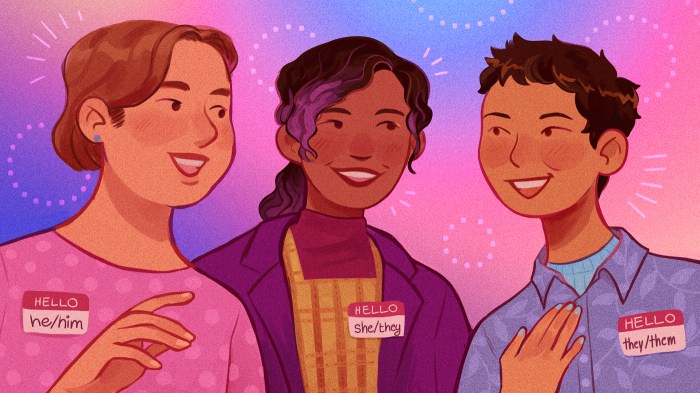
Navigating the complexities of gender identity can be a challenging journey, and for those seeking a deeper understanding, “Redefining Realness: My Path to Womanhood, My Life in Drag” by Janet Mock is an insightful and powerful read. This memoir delves into Mock’s personal experiences as a transgender woman, offering a raw and honest account of her struggles, triumphs, and the transformative power of self-acceptance.
Key Themes and Strengths
Mock’s memoir explores several key themes, including the importance of self-discovery, the challenges of navigating a society that often fails to understand gender identity, and the resilience of the human spirit in the face of adversity. One of the book’s strengths lies in Mock’s ability to convey complex emotions with remarkable honesty and vulnerability.
Her writing is both captivating and thought-provoking, inviting readers to reflect on their own perspectives on gender and identity.
Contributions to Understanding Gender Identity
This book contributes significantly to the understanding of gender identity by providing a firsthand account of what it means to live as a transgender person. Mock’s experiences highlight the diversity of gender expressions and the importance of embracing individuality.
The book also sheds light on the systemic barriers and societal prejudices that transgender individuals face, offering a powerful call for greater understanding and acceptance.
Insights and Perspectives
Through Mock’s journey, readers gain valuable insights into the complexities of gender identity and the challenges of transitioning. The book emphasizes the importance of self-love and acceptance, regardless of societal expectations or prejudices. Mock’s story also serves as a testament to the power of community and the importance of finding support systems that validate and affirm one’s identity.
Key Takeaways and Implications
| Key Takeaways | Implications |
|---|---|
| The importance of self-discovery and embracing one’s true identity. | Individuals should be encouraged to explore their own gender identity and express themselves authentically. |
| The challenges of navigating a society that often fails to understand gender identity. | Greater awareness and education are needed to create a more inclusive and accepting society. |
| The resilience of the human spirit in the face of adversity. | Transgender individuals demonstrate incredible strength and courage in navigating their journeys. |
| The power of community and support systems in affirming one’s identity. | Creating safe and supportive environments is crucial for transgender individuals to thrive. |
Ultimate Conclusion
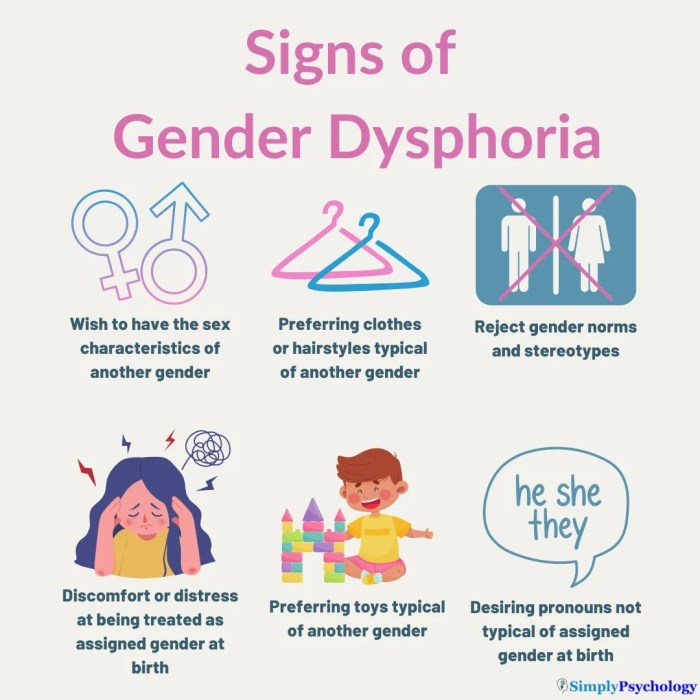
Understanding gender identity is a journey, not a destination. It’s about celebrating the unique tapestry of human experiences and recognizing that each individual’s path is valid and beautiful. By embracing self-acceptance, fostering empathy, and challenging harmful stereotypes, we can create a world where everyone feels seen, heard, and empowered to live their truth.
So, go forth, embrace your authenticity, and rock your own unique vibe!
Common Queries
What’s the difference between gender identity and sexual orientation?
Gender identity is about who you are attracted to romantically or sexually, while sexual orientation is about how you identify your gender. It’s like the difference between who you love and who you are.
How do I ask someone their pronouns?
It’s simple! You can say something like, “What pronouns do you use?” or “How would you like me to address you?”
Is gender dysphoria a mental illness?
Gender dysphoria is not a mental illness. It’s a natural experience that can be caused by a mismatch between an individual’s assigned sex and their gender identity. It’s important to remember that experiencing gender dysphoria doesn’t mean someone is mentally ill, it just means they’re experiencing a disconnect between their internal sense of self and their assigned sex.
What are some resources for people experiencing gender dysphoria?
There are many resources available, including therapists specializing in gender identity, support groups, and online communities. You can also find information and resources on websites like the Human Rights Campaign and the Trevor Project.

